Spartacus Blog
Underground child labour in the coal mining industry did not come to an end in 1842
Wednesday, 2nd August, 2017

A serious accident on 4th July, 1838 at Huskar Colliery in Silkstone, revealed the extent of child labour in the mines. A stream overflowed into the ventilation drift after violent thunderstorms causing the death of 26 children (eleven girls aged from 8 to 16 and fifteen boys between 9 and 12 years of age).
There was nothing very unusual about people being killed working underground. Accidents in shafts caused by rope and chain breakages, flooding, fires, explosions and roof falls killed large numbers of miners. Official statistics were not kept, and powerful colliery owners were often successful at persuading local newspapers not to report the deaths of their workers. By studying all the statistics that are available, one historian has calculated in some collieries in the 19th century, workers had a 50% chance of being killed in a mining accident. (1)
What was different about the Huskar Colliery accident was that details appeared in London newspapers. Queen Victoria read these reports and put pressure on her prime minister, Lord Melbourne, to hold an enquiry into the working conditions in Britain’s factories and mines. (2)
Melbourne approached Anthony Ashley-Cooper (Lord Ashley), who had been campaigning against child labour for many years and played an important role in the passing of the 1833 Factory Act. Under the terms of this legislation it became illegal for children under nine to work in textile factories, whereas children aged between nine and thirteen could not be employed for more than eight hours a day.
Lord Ashley agreed to chair the investigation into children working in the coal-mining industry. He appointed sixteen inspectors to visit the collieries. Two of these men, Robert H. Franks (Wales and Scotland) and John R. Leifchild (Northumberland), produced excellent reports, including several detailed interviews with the children who were working underground.
The investigators discovered that the work in coalmines was hard and dangerous. Coal seams varied in thickness from eighteen inches in Durham to about seven feet in Yorkshire. Narrow seams meant the miners worked in very confined spaces. Where possible, pit ponies were used to carry the coal. However, in narrow seams, women and children had the job of carrying the coal while crawling on their hands and knees. "Children were chained, belted, harnessed like dogs in a go-cart, black, saturated with wet, and more than half-naked - crawling upon their hands and feet, and dragging their heavy loads behind them - they present an appearance indescribably disgusting and unnatural." (3)
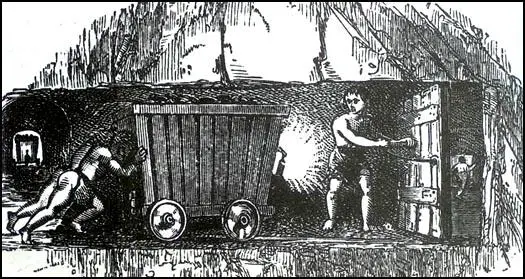
Children who worked in the industry spent most of their life underground: "In 1800 the working day for small boys started at 2 a.m., when the caller-out came round. They were down the pit by three o'clock and did not return until after eight at night. They spent the time minding a door (trappers). As pits went deeper, and underground workings became more extensive, it was important to control the ventilating currents of air." (4)
Keir Hardie found work in the small mining village of Newarthill, working for "twelve or fourteen hours a day". Initially he worked as a trapper. "The work of a trapper was to open and close a door which kept the air supply for the men in a given direction. It was an eerie job, all alone for ten long hours, with the underground silence only disturbed by the sighing and whistling of the air as it sought to escape through the joints of the door." (5)
Alexander Macdonald started working at New Monkland, in Lanarkshire, in 1835: "I entered the mines at about eight years of age. The condition of the miner's boy then was to be raised about 1 o'clock or 2 o'clock in the morning if the distance was very far to travel, and at that time I had to travel a considerable distance, more than three miles. We remained at the mine until 5 and 6 at night. It was an ironstone mine, very low, working about 18 inches, and in some instances not quite so high. Then I moved to coal mines. There we had low seams also, very low seams. There was no rails to draw upon, that is, tramways. We had leather belts for our shoulders. We had to keep dragging the coal with these ropes over our shoulders, sometimes round the middle with a chain between our legs. Then there was always another behind pushing with his head." (6)
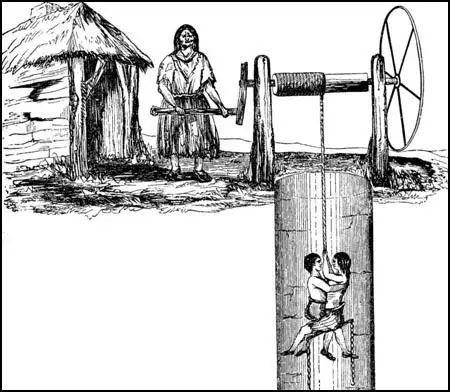
Sarah Gooder, was eight-years old when she was interviewed by one of Lord Ashley's inspectors: "I'm a trapper in the Gawber pit. It does not tire me, but I have to trap without a light and I'm scared. I go at four and sometimes half past three in the morning, and come out at five and half past (in the afternoon).. I never go to sleep. Sometimes I sing when I've light, but not in the dark; I dare not sing then. I don't like being in the pit.... I would like to be at school far better than in the pit." (7)
The children were often beaten for making mistakes. George Anderson was an orphan who worked as the Gosforth Colliery. He was paid 4p a day for his work. "In the night shift I go down at 4 p.m. and come up about 4.30 in the morning. I'm often sleepy. I got my hammers (beaten) twice by being asleep. The putters (men who handled the trams of coal) beat me with their soam-sticks (wooden handles) and hurt me and made me cry because I did not open the doors for them. My door is nearly 2½ miles in. The pit looses (closes) at half past three and though I run I am nigh an hour getting out." (8)
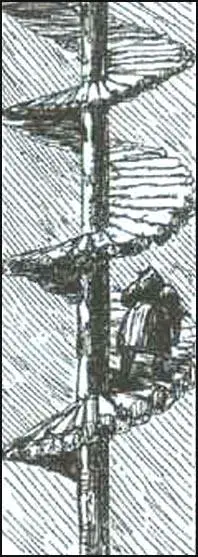
Eric Hopkins, the author claims A Social History of the English Working Classes (1979) claims that the children working in mines were very badly treated: "Children were often beaten as they were in other industries, but in the pits a good deal of cruelty might take place in secret... It was also alleged that immorality was rife in some pits. Men sometimes worked quite naked alongside women who were commonly naked from the waist up, so that (it was said) the women became debased and degraded." (9)
Jane Peacock Watson, a coal-bearer from West Linton was interviewed at the age of forty. She began work as a child and was forced to make her children work underground. "I have wrought in the bowels of the earth 33 years and have been married 23 years, and had nine children. Six are alive, three died of typhus a few years since and I have had two dead born. They were so from the oppressive work. A vast of women have dead children... I have always been obliged to work below till forced to go home to bear the bairn (child). We return as soon as we are able, never longer than 10 or 12 days, many less if they are needed. It is only horse work, and ruins the women. It crushes the haunches, bends their ankles, and makes them old women at 40. Women so soon get weak that they are forced to take the little ones down (the mine) to relieve them; even children of six years of age do much to relieve the burthen". (10)
Where possible, wagons carrying coal, were drawn by horses, and driven by children. However, in low and narrow underground passages, women were used to pull carts full of coal: Betty Harris, worked in a pit in Little Bolton in Lancashire: "I have a belt round my waist, and a chain passing between my legs, and I go on my hands and feet... I have drawn till I have had the skin off me; the belt and chain is worse when we are in the family way." Ann Eggley was employed at Thorpe's Colliery: "The work is far hard for me. Sometimes when we get home at night we have not power to wash ourselves... Father said last night it was both a shame and disgrace for girls to work as we do, but there is nothing else for us to do." (11)
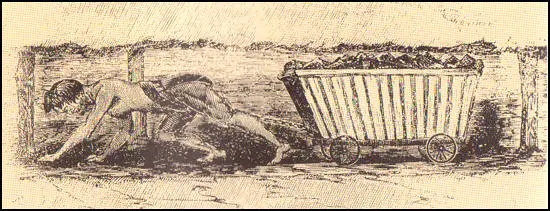
Financial circumstances meant that women continued to do this work while they were pregnant. Betty Wardle explained how she had worked in a pit since she was six years old. One of her children was born while she was underground. "I had a child born in the pits, and I brought it up the pit-shaft in my skirt." When the interviewer questioned the truth of this statement, she replied: "Ay, that I am; it was born the day after I was married, that makes me to know." (12)
Isabel Wilson was 38 years old when she gave evidence to the Children's Employment Commission: "When women have children... they are compelled to take them down early. I have been married 19 years and have had 10 bairns (children); seven are in life. I was a carrier of coals, which caused me to miscarry five times from the strains, and was ill after each. My last child was born on Saturday morning, and I was at work on the Friday night." (13)
Robert Hugh Franks, investigated the problem in Scotland. He interviewed 11 year-old, Janet Cumming: "I carry the large bits of coal from the wall face to the pit bottom, and the small pieces called chows in a creel. The weight is usually a hundredweight. I do not know how many pounds there are in a hundredweight but it is some weight to carry. It takes three journeys to fill a tub of 4 cwt. The distance varies as the work is not always on the same wall, sometimes 150 fathoms, whiles 250 fathoms. The roof is very low and I have to bend my back and legs and the water comes frequently up to the calves of my legs. I have no liking for the work, father makes me like it. I never got hurt, but often am obliged to scramble out of the pit when bad air was in." (14)
Thomas Wilson, the owner of three collieries in the Barnsley area blamed the miners for the problem. "The employment of females of any age in and about the mines is most objectionable, and I should rejoice to see it put an end to; but in the present feeling of the colliers, no individual would succeed in stopping it in a neighbourhood where it prevailed, because the men would immediately go to those pits where their daughters would be employed... The only way effectually to put an end to this and other evils in the present colliery system is to elevate the minds of the men; and the only means to attain this is to combine sound moral and religious training and industrial habits with a system of intellectual culture much more perfect than can at present be obtained by them."
Wilson warned against the idea that the government should pass legislation to protect these women: "I object on general principles to government interference in the conduct of any trade, and I am satisfied that in mines it would be productive of the greatest injury and injustice. The art of mining is not so perfectly understood as to admit of the way in which a colliery shall be conducted being dictated by any person, however experienced, with such certainty as would warrant an interference with the management of private business. I should also most decidedly object to placing collieries under the present provisions of the Factory Act with respect to the education of children employed therein." (15)
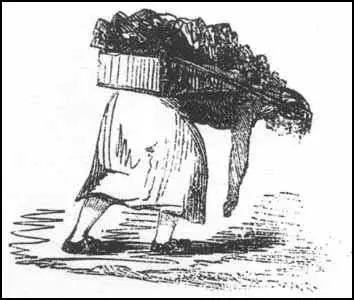
Edward Potter, the manager of the South Heaton Colliery, claimed that he came under great pressure from miners to employ their children: "Of the children in the pits we have none under the age of eight, and only three so young. We are constantly beset by parents coming making application to take children under that age, and they are very anxious, and very dissatisfied if we do not take the children... there have been cases in times of brisk trade, when the parents have threatened to leave the colliery, and go elsewhere if we did not comply." (16)
The Children's Employment Commission published its first report on mines and collieries in 1842. The report caused a sensation when details appeared in newspapers. Ivy Pinchbeck pointed out: "A wider interest was secured for the Report by the woodcuts, since they captured the imagination of many who might not have been tempted to read an ordinary Blue Book. Almost more than by their heavy labour, Victorian England was shocked and horrified by accounts of the naked state of some of the workers." (17)
The majority of people in Britain were unaware that women and children were employed as miners. However, nearly three-quarters of the petitions to Parliament were against the proposed regulation of child labour. As many as 86 per cent of petitions came from the technologically backward districts where higher levels of child labour existed and employer's feared that the change of law would lead to lower profits. (18)
Michael Lavalette pointed out: "Managers and owners in backward coal districts expressed a strong wish to continue the employment of young children... A further clue to varying attitudes at district level towards children's employment lies in the structure of petitioning over the legislation. Between May and August 1842, 160 petitions concerning the Bill were presented to the House of Lords. Of these, 105 petitions originated in the West Riding of Yorkshire and only two emerged from the technology advanced coalfields of Northumberland and Durham." (19)
Within a week of the report being published Lord Ashley gave notice of the Mines and Collieries Bill that he intended to take through Parliament. He wrote in his diary: "The government cannot, if they would refuse the bill of which I have given notice, to exclude females and children from the coal-pits - the feeling in my favour has become quite enthusiastic; the press on all sides is working most vigorously." (20)
Ashley introduced his Bill in a long eloquent speech. "Their labour... is wasteful and ruinous to themselves and their families... They know nothing that they ought to know, they are rendered unfit for the duties of women by overwork, and become utterly demoralized. In the male the moral effects of the system are very sad, but in the female they are infinitely worse, not alone upon themselves, but upon their families, upon society, and, I may add, upon the country itself. It is bad enough if you corrupt the woman, you poison the waters of life at the very fountain." (21)
Two days later he wrote in his diary: "On the 7th, I brought forward my motion - the success has been wonderful, yes, really wonderful - for two hours the House listened so attentively you might have heard a pin drop, broken only by loud and repeated marks of approbation - at the close a dozen members at least followed in succession to give me praise, and express their sense of the holy cause... Many men, I hear shed tears." (22)
Charles Vane, 3rd Marquess of Londonderry, an owner of several collieries, led the opposition in the House of Lords. He presented a petition put forward by the Yorkshire Coal-Owners Association: "With respect to the age at which males should be admitted into mines, the members of this association have unanimously agreed to fix it at eight years... In the thin coal mines it is more especially requisite that boys, varying in age from eight to fourteen, should be employed; as the underground roads could not be made of sufficient height for taller persons without incurring an outlay so great as to render the working of such mines unprofitable". Londonderry declared that some seams of coal required the employment of children; and certain pits, which could not afford to pay men's wages must either employ children or close down. (23)
The measure was passed by the House of Lords on 5th July, 1842. However, it was amended to increased the lowest age of the boys who could work underground from 10 to 13. As a result of this legislation all females were banned from working in the collieries. This is where the history books tend to end the story of children who worked underground. They tend not to point out that the act was a complete failure in ending child labour in the mines.
One of the major problems was that only one inspector was appointed for the entire country and so colliery owners continued to employ women and children in mines. The inspector later admitted that he would only enforce the regulations where a child had been killed in the underground accident. Even then, the fines imposed would often fall "not upon the colliery owner, but upon the father or the guardian of the boy". (24)
In 1850 the Commissioner of Mines, Hugh Seymour Tremenheere, estimated that "200 women and girls were still working in collieries in South Wales, many of whom were only eleven or twelve years of age". (25) The government therefore increased the number of inspectors. Lord Ashley admitted that underground inspection was "altogether impossible, and, indeed, if it were possible it would not be safe... I for one, should be very loath to go down the shaft for the purpose of doing some act that was likely to be distasteful to the colliers below". (26) In his report of 1854, Tremenheere, reported "two instances where persons attempted inspection of their own accord, were maltreated, and very nearly lost their lives." (27)
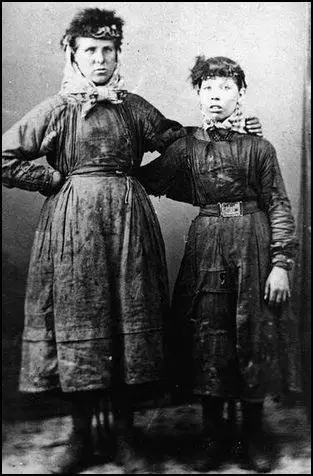
Another difficulty was that parish records of baptisms did not contain a record of birth dates: "This posed huge problems for the inspectors who were frequently presented with unofficial and often falsified forms of evidence by parents... Some suggested the examination of children's teeth as a guide to the ages of applicants, whereas others urged the use of statistical evidence of average heights. Nothing could prevent the frequent practice of parents fraudulently presenting older siblings in order to obtain certificates for their younger offspring." (28)
Peter Kirby, the author of Child Labour in Britain, 1750-1870 (2003), has pointed out that in the long-term, many mine owners stopped employing young children, not because it was illegal, but because they were considered to be inefficient. "In the complicated ventilation systems of larger pits, young and inexperienced 'trappers' were often held responsible for causing explosions by leaving open their ventilation doors, and the exclusion of the very young children from complex ventilation systems, where it was applied, had a tangible effect in reducing accidents from explosions."
He then goes onto argue that "in less advanced colliery districts, where pits were small or where haulage in narrow seams was necessary and demand for child workers relatively higher, colliery owners were afforded virtual immunity from inspection and prosecution under the Act." In other words, "the Mines Act tended to be applied only where it was in the interests of colliery owners". (29)
It was not until 1872 that the age of boys who could work in the coalmines was raised to 12 and eventually to 13 in 1903. Even so, there is a great deal of evidence to show that colliery owners continued to employ children illegally for many years afterwards (see photograph below). (30)
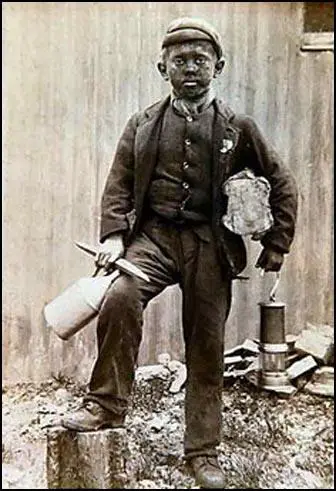
References
(1) John Simkin, Wales in Industrial Britain (1993) page 45
(2) Les Young, Huskar Pit Disaster (20th July, 2007)
(3) Children's Employment Commission Report (1842)
(4) Alan Ereira, The People's England (1981) page 232
(5) William Stewart, J. Keir Hardie: A Biography (1921) page 3
(6) Alexander Macdonald, evidence before the Royal Commission on Trade Unions (28th April, 1868)
(7) Sarah Gooder, Children's Employment Commission Report (1842)
(8) George Anderson, Children's Employment Commission Report (1842)
(9) Eric Hopkins, A Social History of the English Working Classes (1979) page 9
(10) Jane Peacock Watson, Children's Employment Commission Report (1842)
(11) The Physical and Moral Condition of the Children and Young Persons employed in Mines and Manufactures (1843)
(12) Betty Wardle, Children's Employment Commission Report (1842)
(13) Isabel Wilson, Children's Employment Commission Report (1842)
(14) Janet Cumming, aged eleven, interviewed by Robert Hugh Franks, for the Employment of Children and Young Persons in the Collieries of the East of Scotland (1844)
(15) Thomas Wilson, interviewed by Parliamentary Commission (1841)
(16) Edward Potter, manager of the South Heaton Colliery, Children's Employment Commission Report (1842)
(17) Ivy Pinchbeck, Women Workers and the Industrial Revolution (1930) page 266
(18) Peter Kirby, Child Labour in Britain, 1750-1870 (2003) page 14
(19) Michael Lavalette, A Thing of the Past?: Child Labour in Britain 1800 to the Present (1999) page 112
(20) Anthony Ashley-Cooper, diary entry (14th May, 1842)
(21) Anthony Ashley-Cooper, speech in the House of Commons (7th June, 1842)
(22) Anthony Ashley-Cooper, diary entry (9th June, 1842)
(23) Charles Vane, 3rd Marquess of Londonderry, House of Lords (30th June, 1842)
(24) Peter Kirby, Aspects of the Employment of Children in the British Coalmining Industry (1995) page 106
(25) Hugh Seymour Tremenheere, Inspector of Mines Report (1850)
(26) Robert Nelson Boyd, Coal Pits and Pitmen (1892) page 66
(27) Hugh Seymour Tremenheere, Inspector of Mines Report (1854)
(28) Peter Kirby, Aspects of the Employment of Children in the British Coalmining Industry (1995)
(29) Peter Kirby, Child Labour in Britain, 1750-1870 (2003) pages 110
(30) Michael Lavalette, A Thing of the Past?: Child Labour in Britain 1800 to the Present (1999) page 112
Previous Posts
Raymond Asquith, killed in a war declared by his father (28th June, 2017)
History shows since it was established in 1896 the Daily Mail has been wrong about virtually every political issue. (4th June, 2017)
The House of Lords needs to be replaced with a House of the People (7th May, 2017)
100 Greatest Britons Candidate: Caroline Norton (28th March, 2017)
100 Greatest Britons Candidate: Mary Wollstonecraft (20th March, 2017)
100 Greatest Britons Candidate: Anne Knight (23rd February, 2017)
100 Greatest Britons Candidate: Elizabeth Heyrick (12th January, 2017)
100 Greatest Britons: Where are the Women? (28th December, 2016)
The Death of Liberalism: Charles and George Trevelyan (19th December, 2016)
Donald Trump and the Crisis in Capitalism (18th November, 2016)
Victor Grayson and the most surprising by-election result in British history (8th October, 2016)
Left-wing pressure groups in the Labour Party (25th September, 2016)
The Peasant's Revolt and the end of Feudalism (3rd September, 2016)
Leon Trotsky and Jeremy Corbyn's Labour Party (15th August, 2016)
Eleanor of Aquitaine, Queen of England (7th August, 2016)
The Media and Jeremy Corbyn (25th July, 2016)
Rupert Murdoch appoints a new prime minister (12th July, 2016)
George Orwell would have voted to leave the European Union (22nd June, 2016)
Is the European Union like the Roman Empire? (11th June, 2016)
Is it possible to be an objective history teacher? (18th May, 2016)
Women Levellers: The Campaign for Equality in the 1640s (12th May, 2016)
The Reichstag Fire was not a Nazi Conspiracy: Historians Interpreting the Past (12th April, 2016)
Why did Emmeline and Christabel Pankhurst join the Conservative Party? (23rd March, 2016)
Mikhail Koltsov and Boris Efimov - Political Idealism and Survival (3rd March, 2016)
Why the name Spartacus Educational? (23rd February, 2016)
Right-wing infiltration of the BBC (1st February, 2016)
Bert Trautmann, a committed Nazi who became a British hero (13th January, 2016)
Frank Foley, a Christian worth remembering at Christmas (24th December, 2015)
How did governments react to the Jewish Migration Crisis in December, 1938? (17th December, 2015)
Does going to war help the careers of politicians? (2nd December, 2015)
Art and Politics: The Work of John Heartfield (18th November, 2015)
The People we should be remembering on Remembrance Sunday (7th November, 2015)
Why Suffragette is a reactionary movie (21st October, 2015)
Volkswagen and Nazi Germany (1st October, 2015)
David Cameron's Trade Union Act and fascism in Europe (23rd September, 2015)
The problems of appearing in a BBC documentary (17th September, 2015)
Mary Tudor, the first Queen of England (12th September, 2015)
Jeremy Corbyn, the new Harold Wilson? (5th September, 2015)
Anne Boleyn in the history classroom (29th August, 2015)
Why the BBC and the Daily Mail ran a false story on anti-fascist campaigner, Cedric Belfrage (22nd August, 2015)
Women and Politics during the Reign of Henry VIII (14th July, 2015)
The Politics of Austerity (16th June, 2015)
Was Henry FitzRoy, the illegitimate son of Henry VIII, murdered? (31st May, 2015)
The long history of the Daily Mail campaigning against the interests of working people (7th May, 2015)
Nigel Farage would have been hung, drawn and quartered if he lived during the reign of Henry VIII (5th May, 2015)
Was social mobility greater under Henry VIII than it is under David Cameron? (29th April, 2015)
Why it is important to study the life and death of Margaret Cheyney in the history classroom (15th April, 2015)
Is Sir Thomas More one of the 10 worst Britons in History? (6th March, 2015)
Was Henry VIII as bad as Adolf Hitler and Joseph Stalin? (12th February, 2015)
The History of Freedom of Speech (13th January, 2015)
The Christmas Truce Football Game in 1914 (24th December, 2014)
The Anglocentric and Sexist misrepresentation of historical facts in The Imitation Game (2nd December, 2014)
The Secret Files of James Jesus Angleton (12th November, 2014)
Ben Bradlee and the Death of Mary Pinchot Meyer (29th October, 2014)
Yuri Nosenko and the Warren Report (15th October, 2014)
The KGB and Martin Luther King (2nd October, 2014)
The Death of Tomás Harris (24th September, 2014)
Simulations in the Classroom (1st September, 2014)
The KGB and the JFK Assassination (21st August, 2014)
West Ham United and the First World War (4th August, 2014)
The First World War and the War Propaganda Bureau (28th July, 2014)
Interpretations in History (8th July, 2014)
Alger Hiss was not framed by the FBI (17th June, 2014)
Google, Bing and Operation Mockingbird: Part 2 (14th June, 2014)
Google, Bing and Operation Mockingbird: The CIA and Search-Engine Results (10th June, 2014)
The Student as Teacher (7th June, 2014)
Is Wikipedia under the control of political extremists? (23rd May, 2014)
Why MI5 did not want you to know about Ernest Holloway Oldham (6th May, 2014)
The Strange Death of Lev Sedov (16th April, 2014)
Why we will never discover who killed John F. Kennedy (27th March, 2014)
The KGB planned to groom Michael Straight to become President of the United States (20th March, 2014)
The Allied Plot to Kill Lenin (7th March, 2014)
Was Rasputin murdered by MI6? (24th February 2014)
Winston Churchill and Chemical Weapons (11th February, 2014)
Pete Seeger and the Media (1st February 2014)
Should history teachers use Blackadder in the classroom? (15th January 2014)
Why did the intelligence services murder Dr. Stephen Ward? (8th January 2014)
Solomon Northup and 12 Years a Slave (4th January 2014)
The Angel of Auschwitz (6th December 2013)
The Death of John F. Kennedy (23rd November 2013)
Adolf Hitler and Women (22nd November 2013)
New Evidence in the Geli Raubal Case (10th November 2013)
Murder Cases in the Classroom (6th November 2013)
Major Truman Smith and the Funding of Adolf Hitler (4th November 2013)
Unity Mitford and Adolf Hitler (30th October 2013)
Claud Cockburn and his fight against Appeasement (26th October 2013)
The Strange Case of William Wiseman (21st October 2013)
Robert Vansittart's Spy Network (17th October 2013)
British Newspaper Reporting of Appeasement and Nazi Germany (14th October 2013)
Paul Dacre, The Daily Mail and Fascism (12th October 2013)
Wallis Simpson and Nazi Germany (11th October 2013)
The Activities of MI5 (9th October 2013)
The Right Club and the Second World War (6th October 2013)
What did Paul Dacre's father do in the war? (4th October 2013)
Ralph Miliband and Lord Rothermere (2nd October 2013)
